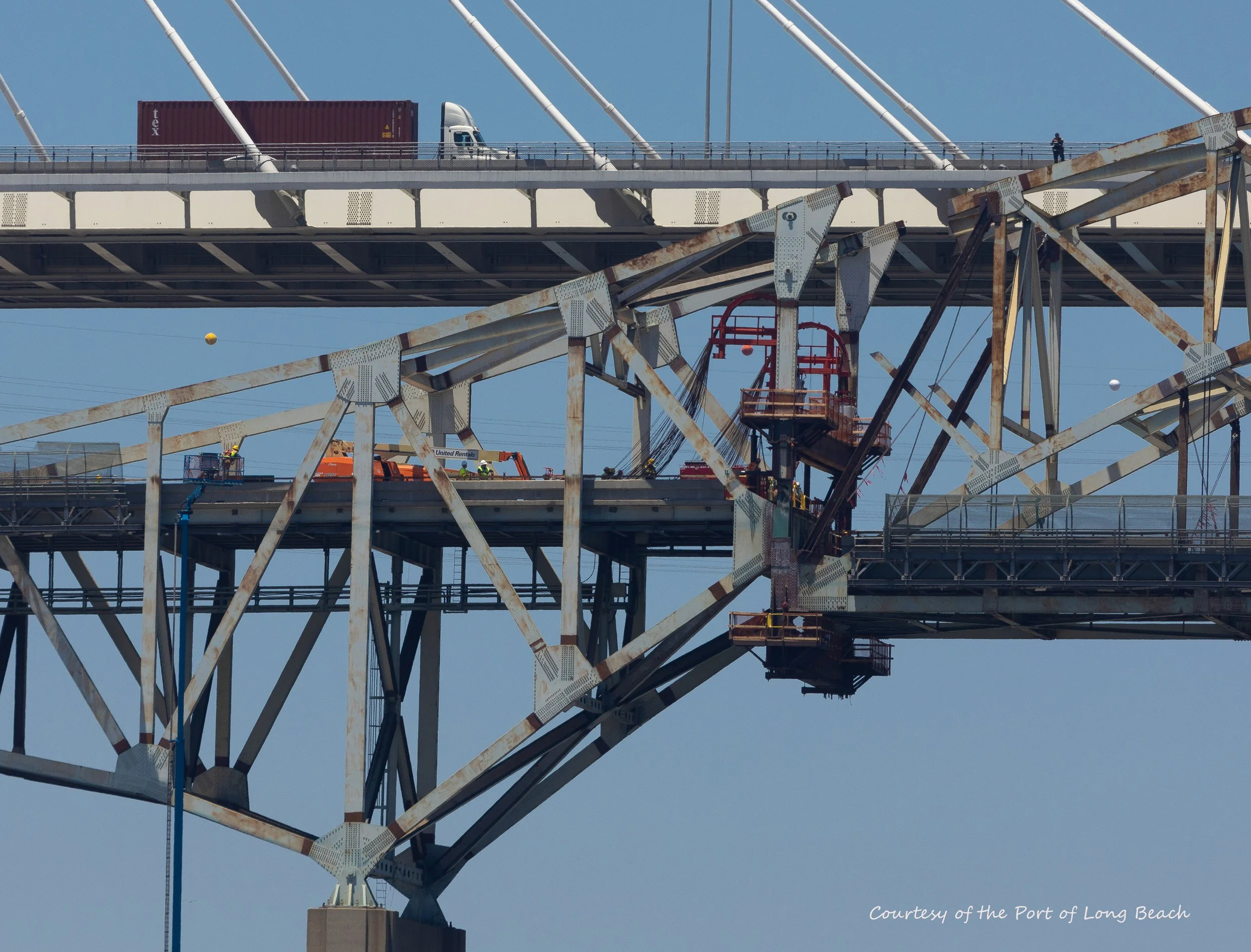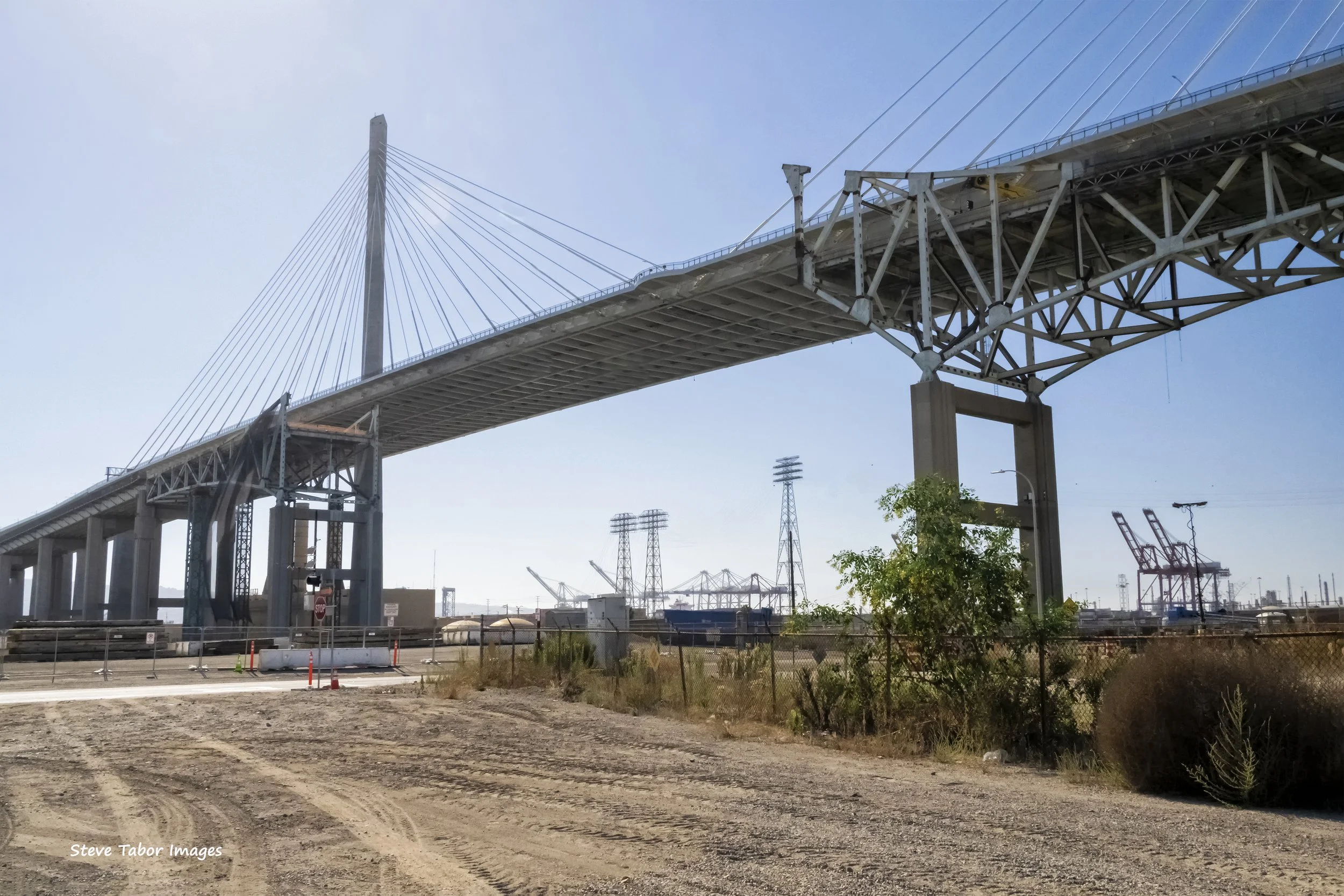Looking Towards A Bigger Tomorrow The Port of Long Beach Begins Demolition of the Gerald Desmond Bridge By Photographer and Contributor Steve Tabor
In July on a Saturday morning, the Port of Long Beach began to remove the fifty-four-year-old Gerald Desmond Bridge (GDB) in order to accommodate the Port’s growing commercial operations and ever-increasing numbers of vehicles carrying commuters and commercial vehicles utilizing the GDB throughout the day to reach local and faraway destinations.
When the new bridge, recently designated as Long Beach International Gateway Bridge (LBIGB), opened in October 2020, drivers immediately benefitted from the increased number traffic lanes and revised bridge access routes from both sides of the bridge. However, that was not the case for the Port’s shipping business.
Both the original GDB and the new LBIGB span a 410-foot waterway that allows access to the Back Channels of the Port. The original GDB’s height of 155 feet above the water was sufficient when the bridge opened in 1968. However, it did not accommodate the height of many of the newer cargo ships utilizing the Port. This reduced the Port’s ability to efficiently manage its maritime commercial traffic. The new LBIGB stands 205 feet above the waterway and easily allows for the newer cargo ships to access the far reaches of the Port creating more options for these ships to load and unload their cargo.
The demolition project began with the most difficult part of the project; the removal of the 410-foot span over the water that allows access to the Back Channel. In order to remove the 410-foot span, a system of steel cables running through hydraulic cylinders known as a strand jack system was mounted to each side of the span on the stable portions of the bridge and to mounting points on the GDB’s main-span.
Once that was in place, the project could proceed. Vehicle traffic on the LBIGB was not interrupted, however, the waterway near and below the span was closed to watercraft and a barge was positioned directly under the span. The plan called for each end of the span to be lowered simultaneously approximately 150 feet to the deck of the barge anchored below. Once the span was safely on the barge, it would be transported to a designated location for dismantling.
According to Duane Kenagy, Port of Long Beach Capital Programs Executive, ”The 3,600 ton main-span was lowered at a rate of approximately three inches per minute, about fifteen feet per hour. It’s boring to watch but that’s exactly what we wanted.”
Recalling the history of the GDB, Port of Long Beach Executive Director, Mario Cordero states, “We became the nation’s premier port for international trade during a period of extraordinary growth, thanks to infrastructure like the Gerald Desmond Bridge. The new bridge shines as a regional landmark that serves as a fitting and lasting tribute to the old span.”
Steven Neal, President of the Long Beach Board of Harbor Commissioners, states, “The Gerald Desmond Bridge served Southern California’s regional transportation network for over 50 years, carrying more than 60,000 commuters and cargo-hauling trucks every day by the time construction started on the new bridge. The new bridge is safer and serves as a symbol of the Port of Long Beach’s position as a primary gateway for trans-Pacific trade.”
The demolition project includes the dismantling and removal of all the GDB’s steel truss spans, steel plate girder approaches, abutments, columns, access ramps, and other pieces of the bridge. Plans call for the metal pieces, concrete and other bridge materials to be recycled wherever possible. Currently, the project is slated to be completed in 2023.
Long Beach International Gateway Bridge (LBIGB) Facts and Figures
· The $1.57 billion budget was jointly funded by the Port of Long Beach, Caltrans, the U.S. Department of Transportation, and the Los Angeles Metropolitan Transportation Authority (Metro). Approximately $59.9 million was earmarked for the removal and demolition of the Gerald Desmond Bridge (GDB).
· The LBIGB has the highest clearance of any cable-stayed bridge in the United States. It is the second tallest cable-stayed bridge in the United States.
· The LBIGB has six traffic lanes capable of handling 68,000 vehicles a day. It features the Mark Bixby Memorial Bicycle-Pedestrian Path.
· The LBIGB is equipped with approximately 200 LED lights designed to illuminate the two 515-feet towers and the 80 suspension cables in twenty-seven different lighting schemes.
· The LBIGB is designed to have a 100-year life span.
· The total length of the LBIGB is 8,800 feet. The 2,000-foot cable-stayed center section is supported by a system of 40 cables anchored to each of the two 515-foot signature towers. Each cable is formed by 45 to 109 individual steel strands.
· A construction technique known as “Bent Ends” allows the east and west approaches and the main bridge span to react independently during an earthquake.
· By the numbers:
o The below ground foundation was formed by more than 350 concrete and rebar piles 6-feet to 8-feet in diameter and 180-feet in length.
o Approximately 18 million pounds of structural steel and 75 million pounds of rebar was used to construct the LBIGB. All steel used to construct the LBIGB was American steel.
o Approximately 1.7 million feet (approximately 332 miles) of cable was used to secure the LBIGB.
· Since Cal Trans is responsible for bridge, the California State Legislature was charged with the responsibility of selecting the final name of the LBIGB.
Who is Gerald Desmond?
Desmond was a long-time resident of the City of Long Beach. During his lifetime he served as a Superior Court Judge, the Long Beach City Attorney and as a member of the Long Beach City Council. Desmond is heralded as a strong advocate for the building of the Bridge and helped secure the necessary funding for the bridge’s construction. Although he lived to see the beginning of the bridge’s construction, he passed away in 1964 at the age of 48 years-old, four years prior to the opening of the transit way bearing his name.
During a retirement ceremony for the original bridge in May, it was disclosed that an overlook on the LBIGB will be named in Gerald Desmond’s honor.
Steve Tabor Bio
This South Bay native’s photographic journey began after receiving his first 35 mm film camera upon earning his Bachelor of Arts degree. Steve began with photographing coastal landscapes and marine life. As a classroom teacher he used photography to share the world and his experiences with his students. Steve has expanded his photographic talents to include portraits and group photography, special event photography as well as live performance and athletics. Steve serves as a volunteer ranger for the Catalina Island Conservancy and uses this opportunity to document the flora and fauna of the island’s interior as well as photograph special events and activities.
Watch for Steve Tabor Images on the worldwide web.















